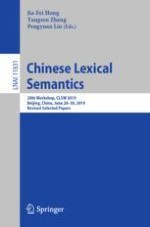2020 | OriginalPaper | Chapter
Difference and Analysis Between the Structures of “Shai(
 ) + NP” and “Xiu(
) + NP” and “Xiu(
 ) + NP”
) + NP”
Authors : Cuiting Hu, Yanqiu Shao
Published in: Chinese Lexical Semantics
Publisher: Springer International Publishing
Activate our intelligent search to find suitable subject content or patents.
Select sections of text to find matching patents with Artificial Intelligence. powered by
Select sections of text to find additional relevant content using AI-assisted search. powered by
Abstract
 ) +
) +
 (happiness)” and “xiu(
(happiness)” and “xiu(
 ) +
) +
 (loves)”, more and more nouns or noun phrases are coming into the structures of “shai(
(loves)”, more and more nouns or noun phrases are coming into the structures of “shai(
 ) + NP” and “xiu(
) + NP” and “xiu(
 ) + NP”. In such a structure, the intuitive and cognitive perception is that “ shai(
) + NP”. In such a structure, the intuitive and cognitive perception is that “ shai(
 ) + NP” and “ xiu(
) + NP” and “ xiu(
 ) + NP” express similar semantic connotations. But in the process of observing the corpus, we find that some nouns or noun phrases are unable to replace each other. With regard to this language phenomenon, we take the BCC Corpus of Beijing Language and Culture University as the research corpus, from which the relevant corpus is extracted, and discuss the similarities and differences between the two language structures from two aspects of word formation ability and collocation words by observing the collocation of index lines.
) + NP” express similar semantic connotations. But in the process of observing the corpus, we find that some nouns or noun phrases are unable to replace each other. With regard to this language phenomenon, we take the BCC Corpus of Beijing Language and Culture University as the research corpus, from which the relevant corpus is extracted, and discuss the similarities and differences between the two language structures from two aspects of word formation ability and collocation words by observing the collocation of index lines.
 .
.  , 2004). (in Chinese)
, 2004). (in Chinese)
 .
.  , (03) (2000)). (in Chinese)
, (03) (2000)). (in Chinese)

 .
.  , (03) (2015)). (in Chinese)
, (03) (2015)). (in Chinese)

 .
.  , (3) (2015)). (in Chinese)
, (3) (2015)). (in Chinese)
 .
.  , (01) (2003)). (in Chinese)
, (01) (2003)). (in Chinese)

 .
.  , (04) (2016)). (in Chinese)
, (04) (2016)). (in Chinese)

 .
.  , (01) (2014)). (in Chinese)
, (01) (2014)). (in Chinese)

 .
.  , (02) (2013)). (in Chinese)
, (02) (2013)). (in Chinese)
 .
.  , (05) (2013)). (in Chinese)
, (05) (2013)). (in Chinese)

 .
.  , (05) (2011)). (in Chinese)
, (05) (2011)). (in Chinese)
 .
.  , (01) (2008)). (in Chinese)
, (01) (2008)). (in Chinese)
 .
.  , (19) (2010)). (in Chinese)
, (19) (2010)). (in Chinese)

 .
.  , (6) (2005)). (in Chinese)
, (6) (2005)). (in Chinese)
 .
.  , 1999(01)). (in Chinese)
, 1999(01)). (in Chinese)
 .
.  , pp. 486–487 (2000)). (in Chinese)
, pp. 486–487 (2000)). (in Chinese)